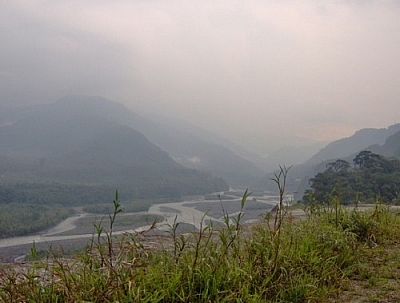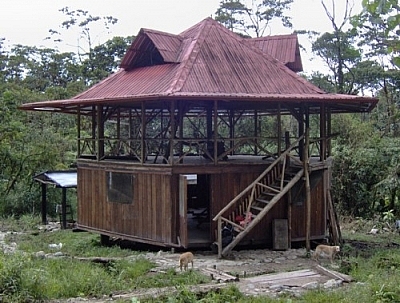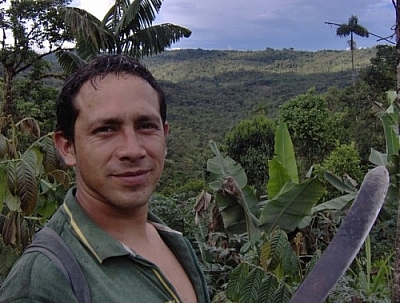Imagine zooming along winding mountain roads in a rickety old bus, feasting your eyes on the changing scenery heading south from Quito, insatiable. Imagine chatting away with an amicable Ecuadorian who points out various sights: a famous waterfall, a deep ravine, a bridge off which to bungee jump, a good discoteca, his own restaurant.
Imagine being dropped off the bus in an unknown town without an address for your destination and being guided by friendly locals until, across the street from your hosts’ house, an elderly neighbour shouts at you from her second-storey window that no one is home. Imagine being walked back the way you just came from by the neighbour’s friend, presumably to the home of your hosts’ employee, only to discover that Guido is in Puyo…
Just off the beaten path, Mera is a small town of approximately 600 inhabitants. It’s an hour from Baños and half an hour from Puyo, situated on the Rio Pastaza. Here, on the edge of the Andes and the Amazonian Basin, you’ll find Merazonia, an animal rescue centre still under construction. Frank Weijand and Jennifer Green, the Dutch and American travellers who founded the refuge, have been working on the project for about three years now and hope to be able to start accepting animals soon.

While I was talking to Guido’s relatives, trying to figure out what to do, Frank showed up to take me back to the house. Apparently, the elderly neighbour hadn’t seen Frank and Jen return home, but sent them after me as soon as she realised her mistake.
When we arrived, I was introduced to David, another volunteer who’d arrived shortly before I had. Early to bed
and early to rise, we were ready for a hard day’s work. After a ten- to fifteen-minute ride in a collectivo, we alighted at the mouth of the 1-kilometre trail that would lead us to the centre.
The path, crossed by multiple small steams and made of uneven, mossy rocks, occasional slippery wooden boards, and deep, sticky mud holes, is challenging but manageable. A covered bridge over the Rio Tigre admits you to Merazonia, where a volunteer house, a bathroom and shower building, a kitchen with running water, and a lounging area are already built. The current main project is the aviary, but other small tasks are abundant as well.

My three weeks at Merazonia were spent:
- searching for fallen wood in the rainforest
- measuring, sawing, planing, and nailing wood
- gathering rocks with Monty the workhorse
- shovelling sand in the river
- lugging buckets of sand or water to various work areas
- painting and varnishing
- mixing cement
Amongst other things, we built a small bridge over a tiny creek, fashioned drawers to put beneath the future volunteers’ beds, built and raised the scaffolding for work on the aviary, spruced up the kitchen counter and cabinets, laid the foundation for the animal-proof dry-waste bin, drilled holes in the metal tubes which form the frame of the aviary, and protected the bottom of the house against termites.
We even found time to take a few day-long jungle hikes! On one of these forays into the selva, pushing our way through thick, wet vegetation, disentangling ourselves from vines, climbing steep mountainsides, sliding down muddy hills, following rocky creek beds, we suddenly came upon a trail. A rare thing to find signs of civilisation in the jungle! We decided to follow it.

There was soon a mystical aura about us as the trees took on a strange appearance. I could no longer see the trunks of trees without craning my neck skywards. Instead, their roots protruded from the ground more than six feet. Walking palms grow new roots to reach different soil, while the old ones rot, allowing them to move — gradually. The surreal trail abruptly ended as we stepped out into a clearing and were greeted by a dazzling panoramic view of mountains and valleys, everything in sight glinting green in the bright sunlight.
Such moments of discovery are not lacking at Merazonia. Most memorably, on my third day there we opted to have lunch on the banks of the Rio Tigre, near rapids, a small waterfall, and a fairly deep pool where swimming is pleasant (but cold!).
After trekking through the rainforest ten minutes to get there, the five of us were sitting in silence, eating slowly, revelling in our peaceful environs when a Menelaus Blue Morpho butterfly passed before our eyes. Alive with excitement, we watched it dance on the wind for five minutes, parading and flaunting its sapphire beauty before settling itself on a branch and inexplicably fading into the surrounding verdure. Inspired, we took several minutes to contemplate what we had seen before returning to work.
Since the workday at Merazonia is only about six to eight hours, with plenty of time to rest at lunch and weekends off, there’s ample leisure time available. There are two particularly good hiking opportunities in Mera itself: one to the summit of a nearby mountain, where it’s common to camp overnight before returning the next day; the other to caves which are best explored with a guide.
In Shell, halfway between Mera and Puyo, there’s a lovely trail through the jungle which culminates with a small zoo. Zip into Shell or Puyo to use the internet or book an adventure excursion with any of the tour operators in Baños or Puyo.
Progress can be slow at Merazonia because apart from the drill and generator, there are no power tools. But working with my hands and seeing a pile of wood and nails become something is satisfying work indeed. Looking back on everything I accomplished over three weeks fills me with pride and gives me a great sense of fulfillment. I left Merazonia knowing that my contribution to such an important cause was valuable. Now I can’t wait to go back and work with the animals I did it all for!
This article originally appeared in inTravel Magazine.
inTravel Magazine has published my article about my time at Merazonia in its Involved section, since the focus is on volunteering.




Search Niackery
×